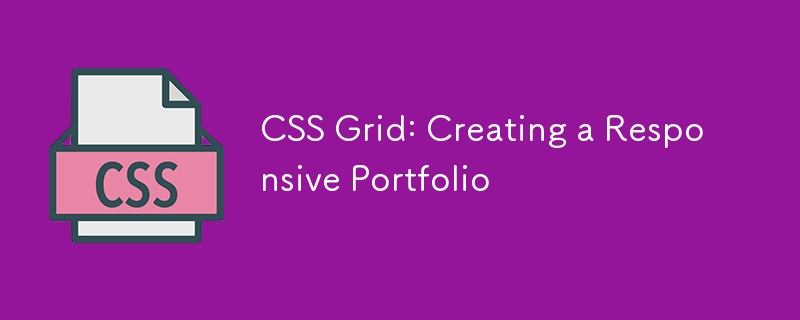CSS Grid: Creating a Responsive Portfolio

Introduction
In today’s digital age, it has become crucial for individuals and businesses to have an online presence. For professionals in the creative field, having a polished and responsive portfolio can make a significant impact on potential clients or employers. This is where CSS Grid comes in - a powerful tool for creating a responsive portfolio that can adapt to any screen size or device.
Advantages of CSS Grid
Flexible and Efficient Layout Design: CSS Grid allows for a flexible and efficient way of designing layouts, making it easier to create responsive websites.
Eliminates the Need for Media Queries: With CSS Grid, you can create complex and dynamic layouts with just a few lines of code, reducing the need for media queries, which can clutter the code and be time-consuming.
Simplified Code and Reduced Errors: By using fewer lines of code to achieve complex layouts, CSS Grid reduces the risk of errors.
Disadvantages of CSS Grid
Browser Compatibility Issues: One of the main issues with CSS Grid is browser compatibility. While most modern browsers support it, older versions may not, leading to a less than optimal user experience.
Steep Learning Curve for Beginners: Compared to other layout methods like Flexbox, CSS Grid may have a steep learning curve for beginners.
Features of CSS Grid
Multiple Layouts Within a Single Container: CSS Grid allows for multiple layouts within a single container, making it perfect for showcasing different projects and styles in a portfolio.
Ability to Re-order Content: CSS Grid has the ability to re-order content based on screen size and device, which is essential for responsive designs.
Example of Using CSS Grid in a Portfolio
.container {
display: grid;
grid-template-columns: repeat(auto-fit, minmax(300px, 1fr));
gap: 20px;
}
.item {
background: #f4f4f4;
border: 1px solid #ccc;
padding: 20px;
}
This CSS snippet sets up a grid container with flexible columns that adapt to the browser's width and adjusts the items inside the container accordingly.
Conclusion
In conclusion, CSS Grid is a game-changer for creating a responsive portfolio. Despite a few drawbacks, the advantages of using CSS Grid far outweigh the disadvantages. With its versatile features and ability to adapt to any screen size, CSS Grid is the go-to solution for creating a professional and responsive portfolio.
The above is the detailed content of CSS Grid: Creating a Responsive Portfolio. For more information, please follow other related articles on the PHP Chinese website!

Hot AI Tools

Undresser.AI Undress
AI-powered app for creating realistic nude photos

AI Clothes Remover
Online AI tool for removing clothes from photos.

Undress AI Tool
Undress images for free

Clothoff.io
AI clothes remover

Video Face Swap
Swap faces in any video effortlessly with our completely free AI face swap tool!

Hot Article

Hot Tools

Notepad++7.3.1
Easy-to-use and free code editor

SublimeText3 Chinese version
Chinese version, very easy to use

Zend Studio 13.0.1
Powerful PHP integrated development environment

Dreamweaver CS6
Visual web development tools

SublimeText3 Mac version
God-level code editing software (SublimeText3)

Hot Topics
 1664
1664
 14
14
 1422
1422
 52
52
 1316
1316
 25
25
 1267
1267
 29
29
 1239
1239
 24
24
 Google Fonts Variable Fonts
Apr 09, 2025 am 10:42 AM
Google Fonts Variable Fonts
Apr 09, 2025 am 10:42 AM
I see Google Fonts rolled out a new design (Tweet). Compared to the last big redesign, this feels much more iterative. I can barely tell the difference
 How to Create an Animated Countdown Timer With HTML, CSS and JavaScript
Apr 11, 2025 am 11:29 AM
How to Create an Animated Countdown Timer With HTML, CSS and JavaScript
Apr 11, 2025 am 11:29 AM
Have you ever needed a countdown timer on a project? For something like that, it might be natural to reach for a plugin, but it’s actually a lot more
 HTML Data Attributes Guide
Apr 11, 2025 am 11:50 AM
HTML Data Attributes Guide
Apr 11, 2025 am 11:50 AM
Everything you ever wanted to know about data attributes in HTML, CSS, and JavaScript.
 A Proof of Concept for Making Sass Faster
Apr 16, 2025 am 10:38 AM
A Proof of Concept for Making Sass Faster
Apr 16, 2025 am 10:38 AM
At the start of a new project, Sass compilation happens in the blink of an eye. This feels great, especially when it’s paired with Browsersync, which reloads
 How We Created a Static Site That Generates Tartan Patterns in SVG
Apr 09, 2025 am 11:29 AM
How We Created a Static Site That Generates Tartan Patterns in SVG
Apr 09, 2025 am 11:29 AM
Tartan is a patterned cloth that’s typically associated with Scotland, particularly their fashionable kilts. On tartanify.com, we gathered over 5,000 tartan
 How to Build Vue Components in a WordPress Theme
Apr 11, 2025 am 11:03 AM
How to Build Vue Components in a WordPress Theme
Apr 11, 2025 am 11:03 AM
The inline-template directive allows us to build rich Vue components as a progressive enhancement over existing WordPress markup.
 While You Weren't Looking, CSS Gradients Got Better
Apr 11, 2025 am 09:16 AM
While You Weren't Looking, CSS Gradients Got Better
Apr 11, 2025 am 09:16 AM
One thing that caught my eye on the list of features for Lea Verou's conic-gradient() polyfill was the last item:
 A Comparison of Static Form Providers
Apr 16, 2025 am 11:20 AM
A Comparison of Static Form Providers
Apr 16, 2025 am 11:20 AM
Let’s attempt to coin a term here: "Static Form Provider." You bring your HTML




